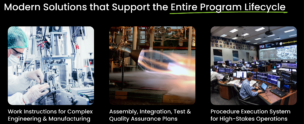Working for a space startup involves a constant rush of fast-paced and demanding tasks.
The design phase is plagued with unknowns and tough decisions; building a supply chain creates countless headaches; and the prototyping stage is riddled with mistakes and rework. The hard work pays off on launch day when a company’s first satellite is deployed to orbit.
What’s next? After the first successful satellite launch, transitioning from development to establishing a robust production system presents a new host of major challenges.
In response to tight timelines and budgets, process development often occurs in tandem with production, a delicate balancing act that demands meticulous coordination and adaptation.
The stakes increase further if an anomaly occurs on the first on-orbit satellite, which prompts a rigorous investigation into its root cause. Program and production leadership can pressure the team for answers, and engineers can be left digging through disorganized folders, team messages, and a patchwork of solutions in search of clarity.
In this chaos, one thing becomes clear: startups need a comprehensive solution to navigate the complexities of manufacturing.
Handling The Pace of New Space
Situations like the one above are all too common in the New Space industry. The product life cycle operates much faster than traditional sectors, requiring a combination of efficient manufacturing and absolute precision.
- The high cost of manufacturing space hardware often means companies have only one or two shots to build a viable spacefaring product.
- If an engineer misses a detail before deployment, there is no Geek Squad in space to fix it. An anomaly could lead to the loss of a multi-million-dollar asset and the business’s downfall.
The industry’s rapid expansion has led to companies often winning large contracts before their internal infrastructure is fully built out, putting further pressure on engineers. While this is a good problem to have, it also means employees are often responsible for multiple deliverables in untested workflows.
Some of the challenges include:
- Rigorous documentation without proportional increases in staffing budgets
- Complete traceability from supply chain to delivery on increased volumes
- On-premise hardware slows and requires maintenance as operations scale
- Rapid scaling leads to increased data management needs
- Managing concurrent dynamic design and manufacturing with rapid feedback loops
A One-System Solution Designed for the Evolving Needs of the Manufacturing Industry
Manufacturo provides a dynamic software solution that combines the essential tools and technology needed to manage and synchronize your production, quality, and supply chain. This all-in-one manufacturing software enhances operational efficiencies, reduces maintenance costs, and is easy to integrate—with setup as fast as one week.
Trusted by a burgeoning list of innovators and pioneers in New Space, Manufacturo is engineered by industry thought leaders with decades of rich experience. It is continuously improved based on New Space customer feedback to ensure it meets the evolving needs of the manufacturing industry.
Consolidating disparate systems into one cohesive, cloud-based platform equips you with a wealth of competitive advantages, including:
- Serving as the single source of truth, as close to reality and real-time as possible, solving complex systematic problems and then getting out of your way.
- Eliminating the need for numerous external software subscriptions, which simplifies data management architecture and reduces the risk of integration errors.
- Enabling manufacturing to go paperless early and consolidate to a single powerful system before scaling.
- Providing consultative support from subject matter experts closely collaborating to help you achieve your advanced manufacturing vision.
Optimizing production systems is essential to eliminating repetitive manual tasks and maintaining efficiency.
Up and to the Right
The space economy has rapidly expanded over the last five years, ushering in thousands of new space startups, large-scale satellite manufacturing, and increased launch cadence.
Last year alone, the US hosted 109 orbital launch attempts, three times more than in 2020. Operators launched 2,232 payloads to orbit last year, up from 974 in 2020, according to astronomer Jonathan McDowell. With the introduction of several new launch vehicles on the horizon, reliable access and cost to orbit will likely continue to improve.
Many of the young startups founded in the last couple of years are now transitioning from the development stage to scaling production. To meet this increased spacecraft and launch demand, new and existing companies can count on Manufacturo to transition them to a mature but agile production infrastructure.




